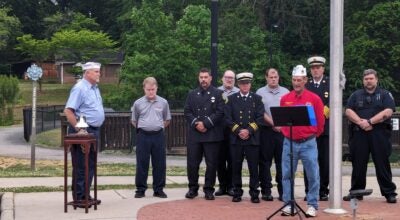NTSB: Pilot in 2012 High Rock Lake crash may have been disoriented
Published 12:00 am Sunday, September 8, 2013
SALISBURY — The Michigan pilot whose Cessna plane crashed into High Rock Lake March 2, 2012, may have become disoriented shortly after leaving the Lexington airport, according to a report released Aug. 27 by the National Transportation Safety Board.
Steve Bown, who had strong ties to NASCAR racing, was killed in the accident, in which his girlfriend Karyn Martin also died. Emergency responders pulled Martin’s body out of the lake the same afternoon as the crash.
Bown’s body was found with pieces of the fuselage about 27 feet below the water’s surface the next morning.
The preliminary NTSB report focuses strongly on the weather conditions when Bown took off from Lexington that day, and it quotes a Federal Aviation Administration advisory about pilot disorientation.
During periods of low visibility, the FAA circular says, “the supporting senses sometimes conflict with what is seen.”
“When this happens, a pilot is particularly vulnerable to disorientation. The degree of disorientation may vary considerably with individual pilots.
“Spatial disorientation to a pilot means simply the inability to tell which way is ‘up.’”
The advisory goes on to say a disoriented pilot “may place an aircraft in a dangerous attitude.”
Bown, 51, was cofounder of Performance Springs in New Hudson, Mich, making automotive valve springs for the racing industry. He reportedly had visited with NASCAR racing team owner Richard Childress the night before on business and was heading for Florida the day of the crash.
The NTSB report says Bown’s plane left Lexington about 1:10 p.m. March 2 and hit the water 30 minutes later. It adds that “marginal visual flight rule conditions” prevailed at the time, and that Bown had filed no flight plan.
Overall, the NTSB investigation includes some 85 pages and photographs, including witness statements, toxicology reports on the victims, pilot training records, work orders on the Cessna and reports from the Rowan County Sheriff’s Office.
The aircraft was not in radio contact with air traffic control when it departed, and no radio transmissions were recorded.
“According to witnesses, they heard the airplane flying overhead but did not see it due to heavy fog,” the NTSB report says.
“… They heard a loud splash in the lake, and as they turned towards the direction of the lake, they saw a large spray of water,” the report continues. “Shortly thereafter, they saw a large amount of debris in the lake.”
The crash occurred in the main channel of High Rock Lake near Cow Island. The island lies at the mouth of Dutch Second Creek, and emergency responders set up their command center at Tamarac Marina.
Witnesses interviewed by the Rowan County Sheriff’s Office that day included Charles E. Scott, who was raking his yard; James W. Wise, who was watching television; Harold Drew, who was fishing in a cove; and Shelia Everhart, who saw the couple at the Lexington airport.
Everhart said the couple had arrived in Lexington about 5:15 p.m. the previous day and rented a vehicle from the airport. At Bown’s instructions, the plane took on 25 gallons of fuel in its right tank and 20 gallons in its left tank before leaving the next day.
Robert R. Carrothers, a lead line technician at the Lexington airport, spoke to Bown before he left, and Bown told him he was headed for Florida.
“The lineman said he mentioned the weather to the pilot, and the pilot responded that he was going to stay below 1,900 feet and that he should be fine,” the report says.
The lineman watched the four-seat Cessna (Columbia 350) take off from runway 24 and said it climbed out normally. He said the weather at the time was visual flight rules “with very light drops of rain,” according to the report.
“The lineman recalled looking at the Automated Weather Observing System monitor, and it was reporting 1,800-foot ceilings and 10 miles visibility, the reports adds. “There were no distress calls made by the pilot or transmissions that the airplane was returning to the airport.”
The FAA advisory on pilot disorientation “recommends that pilots obtain training and maintain proficiency in aircraft control by reference to instruments and to not attempt VFR (visual flight rules) flight when there is a possibility of getting trapped in deteriorating weather.”
The fog became so thick by late afternoon of the crash, recovery teams had to call off the search for Bown’s body until the next morning.
The toxicology report on both victims showed no evidence of alcohol.
Bown had been a private pilot since 2007. The NTSB report says his logbook revealed a total of 290 flight hours, including 174.9 hours of cross-country flight time with 120.3 hours in the accident plane.
The Cessna was built in 2008, had a 310-horsepower engine, and its last annual inspection was completed Dec. 20, 2011, when the plane had 133.6 hours of flight time.
The airplane had a Garmin integrated flight instrument system, but the unit was destroyed in the crash.
A final NTSB report with an official probable cause is expected to be released in coming weeks.
Contact Mark Wineka at 704-797-4263.




